L44-过去时3种情况 初中英语词性句法新讲课件
文档属性
| 名称 | L44-过去时3种情况 初中英语词性句法新讲课件 | 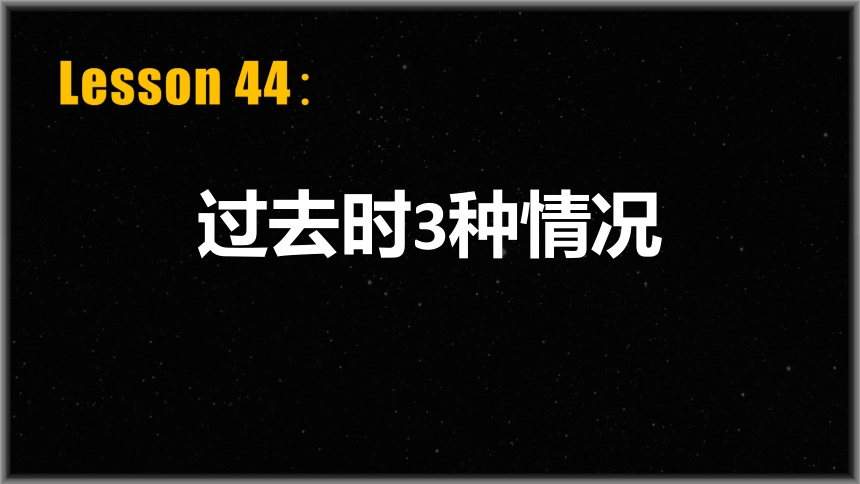 | |
| 格式 | ppt | ||
| 文件大小 | 1.1MB | ||
| 资源类型 | 试卷 | ||
| 版本资源 | 通用版 | ||
| 科目 | 英语 | ||
| 更新时间 | 2022-04-11 09:59:44 | ||
图片预览

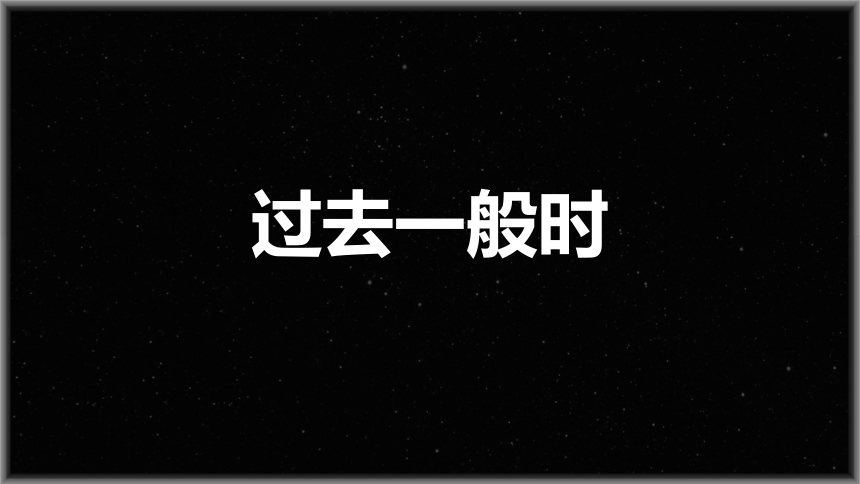
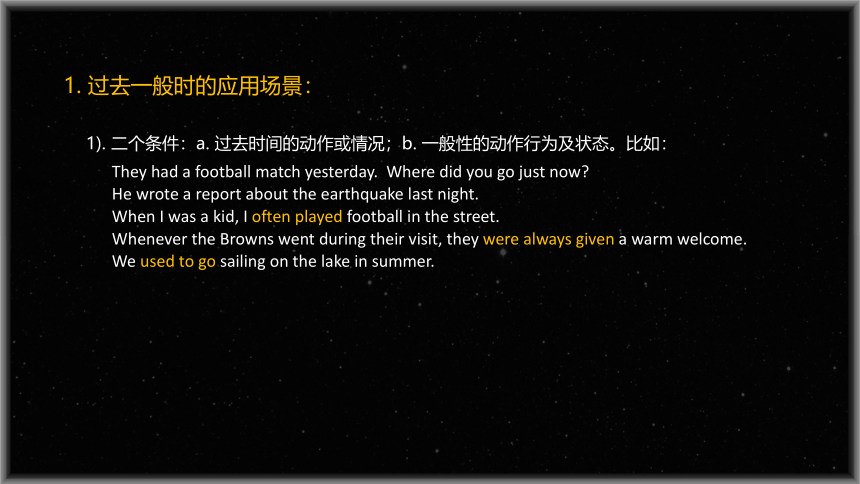
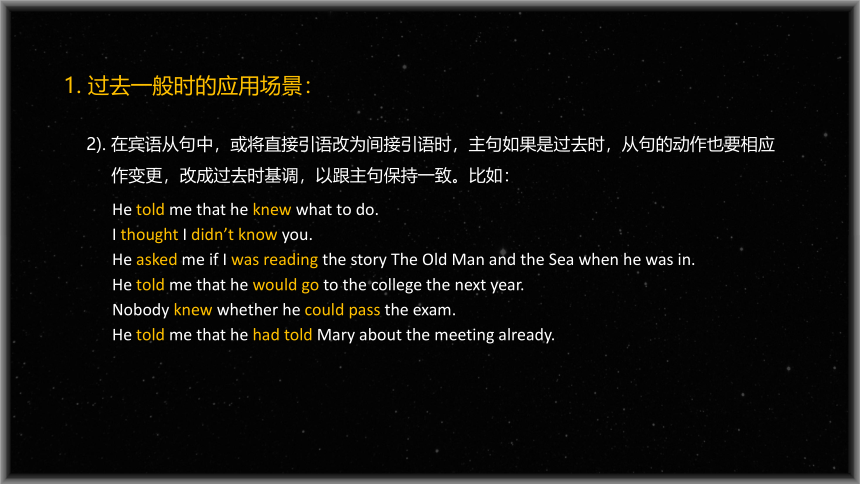
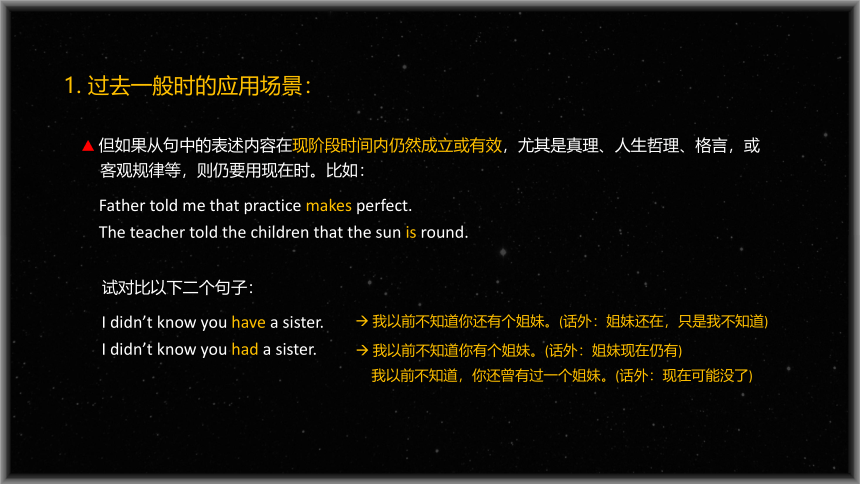
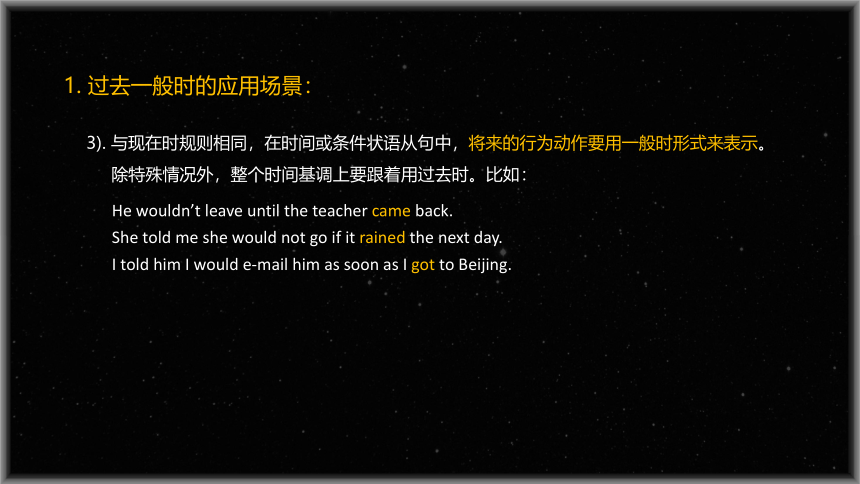
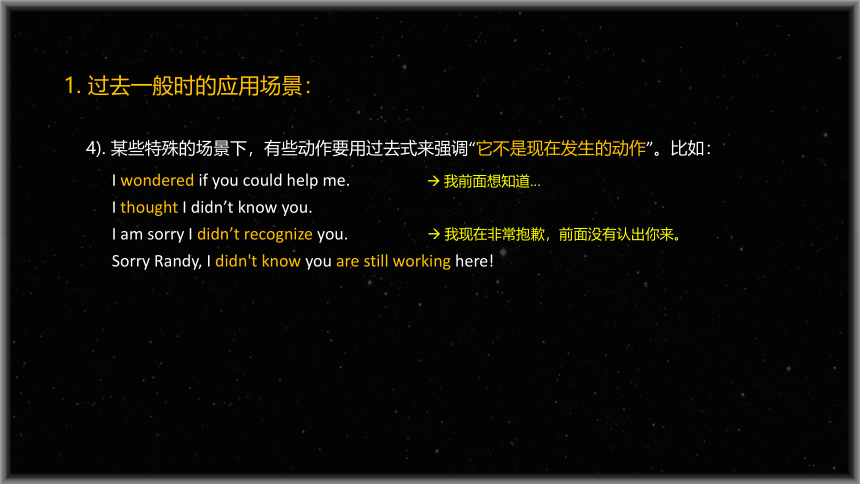
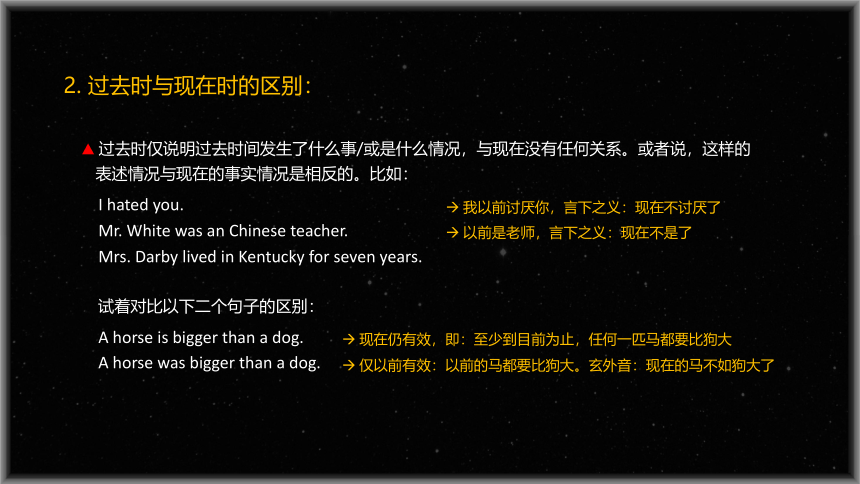
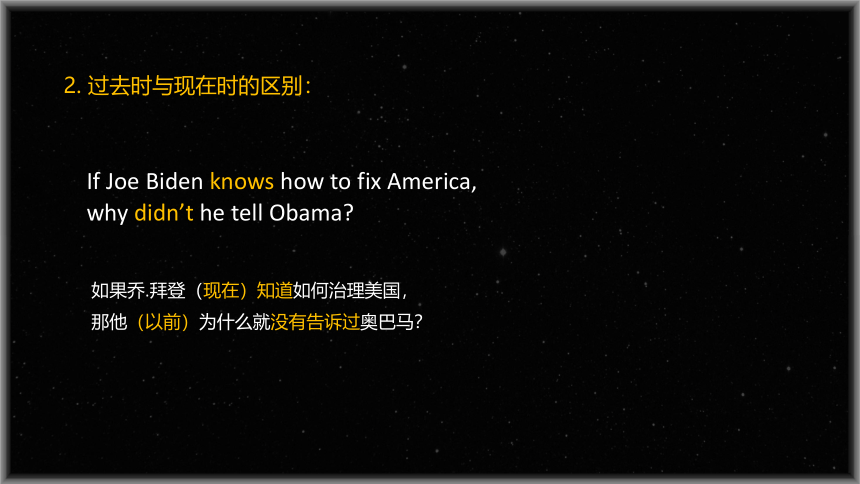
文档简介
(共20张PPT)
过去时3种情况
Lesson 44:
过去一般时
1. 过去一般时的应用场景:
1). 二个条件:a. 过去时间的动作或情况;b. 一般性的动作行为及状态。比如:
They had a football match yesterday. Where did you go just now
He wrote a report about the earthquake last night.
When I was a kid, I often played football in the street.
Whenever the Browns went during their visit, they were always given a warm welcome.
We used to go sailing on the lake in summer.
1. 过去一般时的应用场景:
2). 在宾语从句中,或将直接引语改为间接引语时,主句如果是过去时,从句的动作也要相应
作变更,改成过去时基调,以跟主句保持一致。比如:
He told me that he knew what to do.
I thought I didn’t know you.
He asked me if I was reading the story The Old Man and the Sea when he was in.
He told me that he would go to the college the next year.
Nobody knew whether he could pass the exam.
He told me that he had told Mary about the meeting already.
1. 过去一般时的应用场景:
▲ 但如果从句中的表述内容在现阶段时间内仍然成立或有效,尤其是真理、人生哲理、格言,或
客观规律等,则仍要用现在时。比如:
Father told me that practice makes perfect.
The teacher told the children that the sun is round.
I didn’t know you have a sister.
I didn’t know you had a sister.
试对比以下二个句子:
我以前不知道你还有个姐妹。(话外:姐妹还在,只是我不知道)
我以前不知道你有个姐妹。(话外:姐妹现在仍有)
我以前不知道,你还曾有过一个姐妹。(话外:现在可能没了)
1. 过去一般时的应用场景:
3). 与现在时规则相同,在时间或条件状语从句中,将来的行为动作要用一般时形式来表示。
除特殊情况外,整个时间基调上要跟着用过去时。比如:
He wouldn’t leave until the teacher came back.
She told me she would not go if it rained the next day.
I told him I would e-mail him as soon as I got to Beijing.
1. 过去一般时的应用场景:
4). 某些特殊的场景下,有些动作要用过去式来强调“它不是现在发生的动作”。比如:
I wondered if you could help me.
I thought I didn’t know you.
I am sorry I didn’t recognize you.
Sorry Randy, I didn't know you are still working here!
我前面想知道...
我现在非常抱歉,前面没有认出你来。
2. 过去时与现在时的区别:
▲ 过去时仅说明过去时间发生了什么事/或是什么情况,与现在没有任何关系。或者说,这样的
表述情况与现在的事实情况是相反的。比如:
I hated you.
Mr. White was an Chinese teacher.
Mrs. Darby lived in Kentucky for seven years.
试着对比以下二个句子的区别:
A horse is bigger than a dog.
A horse was bigger than a dog.
现在仍有效,即:至少到目前为止,任何一匹马都要比狗大
仅以前有效:以前的马都要比狗大。玄外音:现在的马不如狗大了
我以前讨厌你,言下之义:现在不讨厌了
以前是老师,言下之义:现在不是了
2. 过去时与现在时的区别:
If Joe Biden knows how to fix America,
why didn’t he tell Obama
如果乔.拜登(现在)知道如何治理美国,
那他(以前)为什么就没有告诉过奥巴马?
2. 过去时与现在时的区别:
某些表示建议/假想的虚拟语气表述句式中一般常用过去时。比如:
A. It(This) is time … 结构中的从句部分:
It is time you went to bed.
I think it’s time you had a word with him.
过去式代表与现在事实相反
2. 过去时与现在时的区别:
C. would rather … 结构中的从句部分:
I’d rather you came tomorrow.
I would rather you didn’t go there.
B. wish/wonder… 结构中的从句部分:
I wish I were twenty years younger.
I wish you would be quiet for a minute.
I wonder if you could give me a hand.
2. 动词的过去式:
A. 规则动作词:
主要通过在后面加“-ed”实现。这部分内容,大部分的语法书中有讲解,此不多述。
B. 不规则动作词:
不规则动词的过去式请见右表
(必前内容)
过去进行时
过去进行时的应用场景:
1). 二个条件:a. 过去时间;b. 强调动作行为正在发生(处于某种状态)。比如:
He was reading a book at that moment.
We were watching TV at this time yesterday.
I was tidying my room the whole morning.
From 8 to ten yesterday morning, they were training in the hall.
My brother fell and hurt himself while he was riding his bicycle.
It was raining when they left the station.
When I got home, my mother was preparing a big meal for our family.
I was sleeping when it started to rain.
As she was reading the newspaper, Granny fell asleep.
中文可以表述为:我正在睡觉时,天开始下雨了。
注意英文中的这种表述法
过去进行时的应用场景:
2). 与现在进行时一样,“go, leave, come”等部分词的过去进行时表示过去将要。比如:
The dark clouds in the sky meant that a storm was coming.
He was leaving the first week in June and staying until September.
3). 在叙述一个过去的场景时,为了使其生动展现,也常常会用过去进行时。比如:
It was a dark night and it was snowing heavily.
Mack was driving down from Vermont, with a stop in Boston to pick Sarah up.
When I arrived home, I found mother going up the wall. The fire was already out, the baby was crying and Johnny had just cut his knee.
进行时表状态,状态句更形象生动
过去完成时
1. 过去完成时的应用场景:
1). 到过去某个时间为止,业已完成的动作行为或状态。跟现在没有任何关系。比如:
I had finished reading the novel by nine o’clock last night.
We had learned over two thousand English words by the end of last term.
By the time of last year, we had built two bridges.
The bus had already left by the time I got there.
I had learned 1000 English words till then.
They had planted six hundred trees before last Wednesday.
The couple had been living together for 16 years.
▲ 时间状语一般常用:by + (过去某时间), till + (过去某时间), before + (过去某时间)
1. 过去完成时的应用场景:
2). 表示在过去某动作之前业已完成的另一个动作行为或状态。 比如:
I thought we had been cheated.
I found that my flat had been stolen.
She said that she had seen the film before.
She found the key that she had lost.
We had hoped that you would come, but you didn’t. (主句动作在前)
After he (had) finished his homework, he went to bed.
My parents had been married for 3 years before they left for the United States.
注意英文中的这种表述法
▲ 常用在带有宾语从句、定语从句或状语从句的主从复合句中。
I had been at the bus stop for 20 minutes when a bus finally came.
1. 过去完成时的应用场景:
3). 在“It was…, This was…”句式中,一般用过去完成时。比如:
It was the first time that I had visited the city.
This was the third time that the boy had been late.
It was the third time that he had been out of work that year.
2. 过去完成时与现在完成时的区别:
* 现在完成时表示的动作虽然起始于过去时间发生,但与现在有关。
它侧重该动作对现在产生的结果或造成的影响;
* 过去完成时以过去时间为基点,它强调某个动作或状态发生在“过去的过去”。
I have learned 1000 English words so far (迄今为止).
I had learned 1000 English words till then.
对比以下二个句子:
过去时3种情况
Lesson 44:
过去一般时
1. 过去一般时的应用场景:
1). 二个条件:a. 过去时间的动作或情况;b. 一般性的动作行为及状态。比如:
They had a football match yesterday. Where did you go just now
He wrote a report about the earthquake last night.
When I was a kid, I often played football in the street.
Whenever the Browns went during their visit, they were always given a warm welcome.
We used to go sailing on the lake in summer.
1. 过去一般时的应用场景:
2). 在宾语从句中,或将直接引语改为间接引语时,主句如果是过去时,从句的动作也要相应
作变更,改成过去时基调,以跟主句保持一致。比如:
He told me that he knew what to do.
I thought I didn’t know you.
He asked me if I was reading the story The Old Man and the Sea when he was in.
He told me that he would go to the college the next year.
Nobody knew whether he could pass the exam.
He told me that he had told Mary about the meeting already.
1. 过去一般时的应用场景:
▲ 但如果从句中的表述内容在现阶段时间内仍然成立或有效,尤其是真理、人生哲理、格言,或
客观规律等,则仍要用现在时。比如:
Father told me that practice makes perfect.
The teacher told the children that the sun is round.
I didn’t know you have a sister.
I didn’t know you had a sister.
试对比以下二个句子:
我以前不知道你还有个姐妹。(话外:姐妹还在,只是我不知道)
我以前不知道你有个姐妹。(话外:姐妹现在仍有)
我以前不知道,你还曾有过一个姐妹。(话外:现在可能没了)
1. 过去一般时的应用场景:
3). 与现在时规则相同,在时间或条件状语从句中,将来的行为动作要用一般时形式来表示。
除特殊情况外,整个时间基调上要跟着用过去时。比如:
He wouldn’t leave until the teacher came back.
She told me she would not go if it rained the next day.
I told him I would e-mail him as soon as I got to Beijing.
1. 过去一般时的应用场景:
4). 某些特殊的场景下,有些动作要用过去式来强调“它不是现在发生的动作”。比如:
I wondered if you could help me.
I thought I didn’t know you.
I am sorry I didn’t recognize you.
Sorry Randy, I didn't know you are still working here!
我前面想知道...
我现在非常抱歉,前面没有认出你来。
2. 过去时与现在时的区别:
▲ 过去时仅说明过去时间发生了什么事/或是什么情况,与现在没有任何关系。或者说,这样的
表述情况与现在的事实情况是相反的。比如:
I hated you.
Mr. White was an Chinese teacher.
Mrs. Darby lived in Kentucky for seven years.
试着对比以下二个句子的区别:
A horse is bigger than a dog.
A horse was bigger than a dog.
现在仍有效,即:至少到目前为止,任何一匹马都要比狗大
仅以前有效:以前的马都要比狗大。玄外音:现在的马不如狗大了
我以前讨厌你,言下之义:现在不讨厌了
以前是老师,言下之义:现在不是了
2. 过去时与现在时的区别:
If Joe Biden knows how to fix America,
why didn’t he tell Obama
如果乔.拜登(现在)知道如何治理美国,
那他(以前)为什么就没有告诉过奥巴马?
2. 过去时与现在时的区别:
某些表示建议/假想的虚拟语气表述句式中一般常用过去时。比如:
A. It(This) is time … 结构中的从句部分:
It is time you went to bed.
I think it’s time you had a word with him.
过去式代表与现在事实相反
2. 过去时与现在时的区别:
C. would rather … 结构中的从句部分:
I’d rather you came tomorrow.
I would rather you didn’t go there.
B. wish/wonder… 结构中的从句部分:
I wish I were twenty years younger.
I wish you would be quiet for a minute.
I wonder if you could give me a hand.
2. 动词的过去式:
A. 规则动作词:
主要通过在后面加“-ed”实现。这部分内容,大部分的语法书中有讲解,此不多述。
B. 不规则动作词:
不规则动词的过去式请见右表
(必前内容)
过去进行时
过去进行时的应用场景:
1). 二个条件:a. 过去时间;b. 强调动作行为正在发生(处于某种状态)。比如:
He was reading a book at that moment.
We were watching TV at this time yesterday.
I was tidying my room the whole morning.
From 8 to ten yesterday morning, they were training in the hall.
My brother fell and hurt himself while he was riding his bicycle.
It was raining when they left the station.
When I got home, my mother was preparing a big meal for our family.
I was sleeping when it started to rain.
As she was reading the newspaper, Granny fell asleep.
中文可以表述为:我正在睡觉时,天开始下雨了。
注意英文中的这种表述法
过去进行时的应用场景:
2). 与现在进行时一样,“go, leave, come”等部分词的过去进行时表示过去将要。比如:
The dark clouds in the sky meant that a storm was coming.
He was leaving the first week in June and staying until September.
3). 在叙述一个过去的场景时,为了使其生动展现,也常常会用过去进行时。比如:
It was a dark night and it was snowing heavily.
Mack was driving down from Vermont, with a stop in Boston to pick Sarah up.
When I arrived home, I found mother going up the wall. The fire was already out, the baby was crying and Johnny had just cut his knee.
进行时表状态,状态句更形象生动
过去完成时
1. 过去完成时的应用场景:
1). 到过去某个时间为止,业已完成的动作行为或状态。跟现在没有任何关系。比如:
I had finished reading the novel by nine o’clock last night.
We had learned over two thousand English words by the end of last term.
By the time of last year, we had built two bridges.
The bus had already left by the time I got there.
I had learned 1000 English words till then.
They had planted six hundred trees before last Wednesday.
The couple had been living together for 16 years.
▲ 时间状语一般常用:by + (过去某时间), till + (过去某时间), before + (过去某时间)
1. 过去完成时的应用场景:
2). 表示在过去某动作之前业已完成的另一个动作行为或状态。 比如:
I thought we had been cheated.
I found that my flat had been stolen.
She said that she had seen the film before.
She found the key that she had lost.
We had hoped that you would come, but you didn’t. (主句动作在前)
After he (had) finished his homework, he went to bed.
My parents had been married for 3 years before they left for the United States.
注意英文中的这种表述法
▲ 常用在带有宾语从句、定语从句或状语从句的主从复合句中。
I had been at the bus stop for 20 minutes when a bus finally came.
1. 过去完成时的应用场景:
3). 在“It was…, This was…”句式中,一般用过去完成时。比如:
It was the first time that I had visited the city.
This was the third time that the boy had been late.
It was the third time that he had been out of work that year.
2. 过去完成时与现在完成时的区别:
* 现在完成时表示的动作虽然起始于过去时间发生,但与现在有关。
它侧重该动作对现在产生的结果或造成的影响;
* 过去完成时以过去时间为基点,它强调某个动作或状态发生在“过去的过去”。
I have learned 1000 English words so far (迄今为止).
I had learned 1000 English words till then.
对比以下二个句子:
同课章节目录
- 词法
- 名词
- 动词和动词短语
- 动词语态
- 动词时态
- 助动词和情态动词
- 非谓语动词
- 冠词
- 代词
- 数词和量词
- 形容词副词及其比较等级
- 介词和介词短语
- 连词和感叹词
- 构词法
- 相似、相近词比较
- 句法
- 陈述句
- 一般疑问句和否定疑问句
- 特殊疑问句及选择疑问句
- 反意疑问句
- 存在句(There be句型)
- 宾语从句
- 定语从句
- 状语从句
- 主谓一致问题
- 简单句
- 并列句
- 复合句
- 主谓一致
- 主、表语从句
- 名词性从句
- 直接引语和间接引语
- 虚拟语气
- 感叹句
- 强调句
- 倒装句
- 祈使句
- 句子的成分
- 句子的分类
- 题型专区
- 单项选择部分
- 易错题
- 完形填空
- 阅读理解
- 词汇练习
- 听说训练
- 句型转换
- 补全对话
- 短文改错
- 翻译
- 书面表达
- 任务型阅读
- 语法填空
- 其他资料
